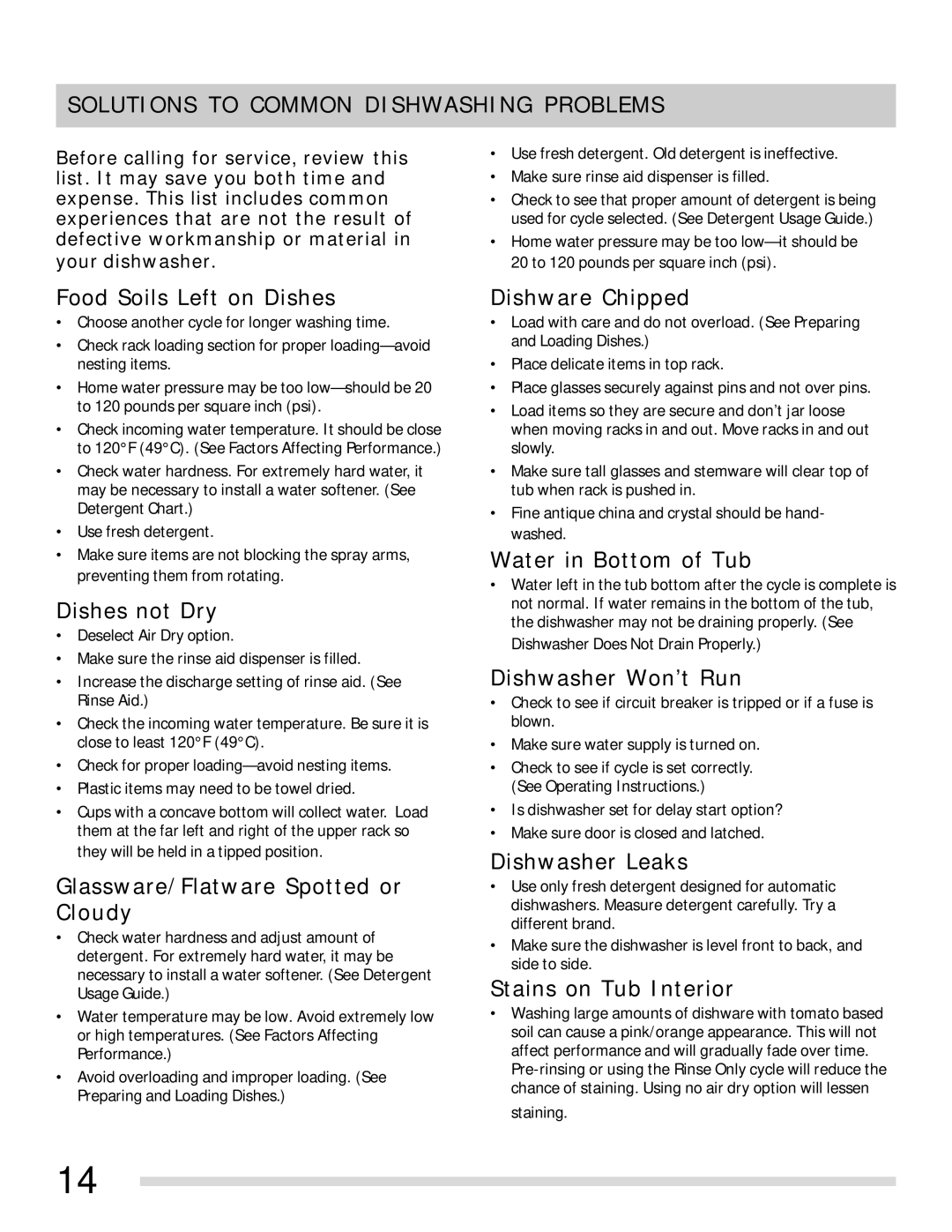
SOLUTIONS TO COMMON DISHWASHING PROBLEMS
Before calling for service, review this list. It may save you both time and expense. This list includes common experiences that are not the result of defective workmanship or material in
your dishwasher.
•Use fresh detergent. Old detergent is ineffective.
•Make sure rinse aid dispenser is filled.
•Check to see that proper amount of detergent is being used for cycle selected. (See Detergent Usage Guide.)
•Home water pressure may be too
Food Soils Left on Dishes
•Choose another cycle for longer washing time.
•Check rack loading section for proper
•Home water pressure may be too
•Check incoming water temperature. It should be close to 120°F (49°C). (See Factors Affecting Performance.)
•Check water hardness. For extremely hard water, it may be necessary to install a water softener. (See Detergent Chart.)
•Use fresh detergent.
•Make sure items are not blocking the spray arms, preventing them from rotating.
Dishes not Dry
•Deselect Air Dry option.
•Make sure the rinse aid dispenser is filled.
•Increase the discharge setting of rinse aid. (See Rinse Aid.)
•Check the incoming water temperature. Be sure it is close to least 120°F (49°C).
•Check for proper
•Plastic items may need to be towel dried.
•Cups with a concave bottom will collect water. Load them at the far left and right of the upper rack so they will be held in a tipped position.
Glassware/Flatware Spotted or Cloudy
•Check water hardness and adjust amount of detergent. For extremely hard water, it may be necessary to install a water softener. (See Detergent Usage Guide.)
•Water temperature may be low. Avoid extremely low or high temperatures. (See Factors Affecting Performance.)
•Avoid overloading and improper loading. (See Preparing and Loading Dishes.)
Dishware Chipped
•Load with care and do not overload. (See Preparing and Loading Dishes.)
•Place delicate items in top rack.
•Place glasses securely against pins and not over pins.
•Load items so they are secure and don’t jar loose when moving racks in and out. Move racks in and out slowly.
•Make sure tall glasses and stemware will clear top of tub when rack is pushed in.
•Fine antique china and crystal should be hand- washed.
Water in Bottom of Tub
•Water left in the tub bottom after the cycle is complete is not normal. If water remains in the bottom of the tub, the dishwasher may not be draining properly. (See Dishwasher Does Not Drain Properly.)
Dishwasher Won’t Run
•Check to see if circuit breaker is tripped or if a fuse is blown.
•Make sure water supply is turned on.
•Check to see if cycle is set correctly. (See Operating Instructions.)
•Is dishwasher set for delay start option?
•Make sure door is closed and latched.
Dishwasher Leaks
•Use only fresh detergent designed for automatic dishwashers. Measure detergent carefully. Try a different brand.
•Make sure the dishwasher is level front to back, and side to side.
Stains on Tub Interior
•Washing large amounts of dishware with tomato based soil can cause a pink/orange appearance. This will not affect performance and will gradually fade over time.
14
